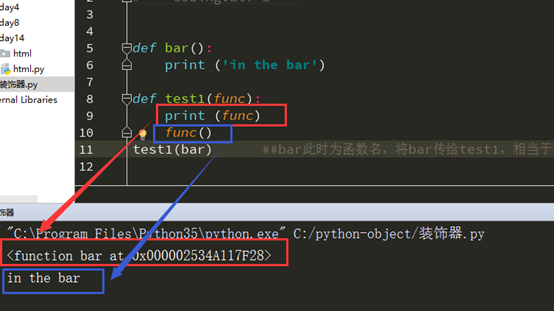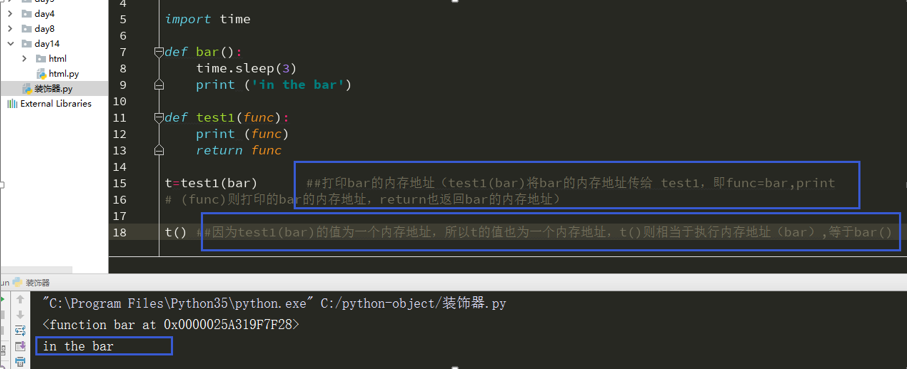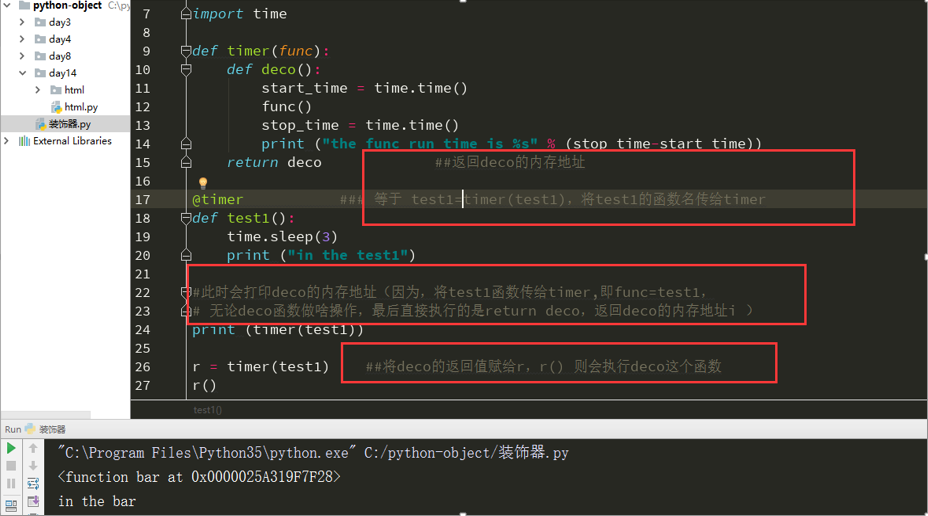python 函数基础及装饰器
2024-10-20 06:34:26
没有参数的函数及return操作
def test1():
print ("welcome") def test2():
print ("welcomt test2")
return def test3():
print("welcome test3")
return ,,,["test3","retest"] x = test1() #test1()表示执行,将执行结果(返回值)赋给变量x,会自动执行,并且由于test1 没有返回值(没有return操作),print的时候会打印none
y = test2() #test2()执行,有print,也有return,由于return一个返回值,所以将return的值赋给变量y
z = test3() print (x)
print (test1) ----test1没有执行,会打印test1的内存对象
print (y)
print (z) 打印结果:
welcome ----》x的打印结果
welcomt test2 ----》 y的打印结果
welcome test3 ----》 z的打印结果
None ----》x的打印结果
0 -----》y的打印结果
(, , , ['test3', 'retest']) ---》z的打印结果 总结:
只有当函数赋给一个变量时,返回值才能打印出来
当返回值为0时(没有return操作):返回none
当返回值为1时(return n):返回n
当返回值大于1时(return a,b,bv,d):返回元组(a,b,bv,d)

带参数的函数
#位置参数调用
def test1(x,y): ##这里的x,y称之为形参
print (x)
print (y) test1(,) ###这里的1,2称之为实参 注:形参和实参位置必须一一对应,##关键参数不能写在位置参数前面 ##关键字调用,与形参顺序无关
def test1(x,y):
print (x)
print (y) test1(y=,x=) 这里 y=1 将值传给y,x=2将值传给x
参数组(非固定参数)
#打印出一个元组(n个参数转换成元组)
def test1(*args): ##传多个位置参数(及单个字符串类的参数),在参数不固定的情况下
print (args) test1(,,,,) ##打印一个字典(n个参数转换成字典)
def test1(**kwargs): ###接收多个关键字参数(及 键=值 类似的参数)
print (kwargs) test1(name='aa',age=,sex="man") 注:参数组一定要放在后面
高阶函数和嵌套函数
高阶函数说明:
- A:函数名当作实参传递给另一个函数
- B:函数名可以作为返回值
示例一:将函数名作为实参,传递给另一个函数

打印结果:

示例二:将函数名作为返回值
def bar():
print ('in the bar')
return "xx"
def test1(func):
print (func)
return func #func为传递进来的函数名,作为返回值返回,return的结果一个内存对象 print (test1(bar)) ##打印bar的内存地址(test1(bar)即将bar的内存作为参数地址传给 test1,即func=bar,print (func)则打印的bar的内存地址,return也返回bar的内存地址)
x=test1(bar) #这里bar不能加括号’()’,加了括号相当于把bar的返回值(相当于执行了bar,返回值为xx)传过去了,而不是传了一个函数
print (x()) #相当于执行了bar函数
执行结果:
<function bar at 0x0000020090A57F28> #print(func) 的值
<function bar at 0x0000020090A57F28> #return func的值
<function bar at 0x0000020090A57F28> X = test1(bar)的值
in the bar #x()的值
xx
示例:

retrun func 返回func的内存地址,t()相当于执行func,返回func函数的执行结果
嵌套函数
def foo():
print ('in the foo')
def bar():
print ('in the bar')
bar() foo() 打印结果: in the foo
in the bar
装饰器
一、无参数装饰器
import time def timer(func):
def deco():
start_time = time.time()
func() #func()=test1()
stop_time = time.time()
print ("the func run time is %s" % (stop_time-start_time))
return deco ##返回deco的内存地址 @timer ### 等价于 test1=timer(test1),将test1函数的作为实参传给timer,所以test1=func,func()=test1()
def test1():
time.sleep(3)
print ("in the test1") print (timer(test1)) ##打印deco的内存地址#此时会打印deco的内存地址(因为,将test1函数传给timer,即func=test1,此时无论deco函数做啥操作,deco函数都没有执行,最后直接执行的是return deco,返回deco的内存地址) r = timer(test1) ##将deco的返回值(内存地址)赋给r,r() 则会执行deco这个函数(即deco())
r()
打印结果:
<function timer.<locals>.deco at 0x00000182EEAE9EA0>
in the test1
the func run time is 3.000403881072998
the func run time is 3.003307342529297
实例二
import time def timer(func):
def deco():
start_time = time.time()
func() ###这里即执行 test1函数(func=test1) stop_time = time.time()
print ("the func run time is %s" % (stop_time-start_time))
return deco @timer ### 等于 timer(test1),此时test1为一个内存对象
def test1():
time.sleep(3)
print ("in the test1") test1() 打印结果:
in the test1
the func run time is 3.0003435611724854

带参数的装饰器
带参数的装饰器即为在要被装饰的的函数里传入参数。例:
#所有参数可用*args,**kwargs代替 import time
def timer(func):
def deco(arg1):
start_time = time.time()
func(arg1) ###这里相当于执行test2(‘aaa’)
stop_time = time.time()
print ("the func run time is %s" % (stop_time-start_time))
return deco ##返回deco的内存地址 @timer
def test2(aa): ##相当于将test2函数作为实参传给timer,即test2=timer(test2),test2=func ,func声明了deco函数,但没有执行,此时返回了deco的内存地址(deco加上括号“()”即可执行,所以test2()=deco()),
#所以 test2()传入一个参数执行等于deco()传入一个参数执行,
time.sleep(2)
print ('in the test2 %s ' % aa)
#r1 = timer(test2)
#r1("bb") ##根据上面说明,r1的结果为deco的内存地址,r1()执行就等于 deco()执行
test2('aaa') ##test2(‘aaa’) 即等于 deco(‘aaa’),所以deco函数也要加上参数
打印结果
in the test2 aaa
the func run time is 2.0001180171966553
装饰器内部参数判断
#_*_coding:utf-8_*_ user_status = False #用户登录了就把这个改成True def login(auth_type): #把要执行的模块从这里传进来
def auth(func):
def inner(*args,**kwargs):#再定义一层函数
if auth_type == "qq":
_username = "alex" #模拟这是DB里存的用户信息
_password = "abc!23" #模拟这是DB里存的用户信息
global user_status if user_status == False:
username = input("user:")
password = input("pasword:") if username == _username and password == _password:
print("welcome login....")
user_status = True
else:
print("wrong username or password!") if user_status == True:
return func(*args,**kwargs) # 看这里看这里,只要验证通过了,就调用相应功能
else:
print("only support qq ")
return inner #用户调用login时,只会返回inner的内存地址,下次再调用时加上()才会执行inner函数 return auth def home():
print("---首页----") @login('qq')
def america():
#login() #执行前加上验证
print("----衣服专区----") def japan():
print("----化妆品专区----") @login('weibo')
def henan(style):
'''
:param style: 喜欢看什么类型的,就传进来
:return:
'''
#login() #执行前加上验证
print("----河南专区----") home()
# america = login(america) #你在这里相当于把america这个函数替换了
#henan = login(henan) # #那用户调用时依然写
america() # henan("3")
实例二
import time def timer(auth_type):
def warpper(func):
def deco(*args,**kwargs):
if auth_type == "local":
print ("welcome to local auth %s" % auth_type)
start_time = time.time()
func()
stop_time = time.time()
print ("the func run time is %s" % (stop_time-start_time))
else:
print ("ni da ye de %s" % auth_type)
return deco
return warpper @timer(auth_type="ldap") ### 等于 test1=timer(test1) 这里timer加上了括号并传了参数,会将auth_type的值传给timmer函数,然后会执行warpper(),
# 此时还没有调用(需要在最下面调用test1和test2的时候才会调用执行)
def test1():
time.sleep(3)
print ("in the test1") @timer(auth_type="local") ##这里的参数为作装饰器函数的参数
def test2():
print ("in the test2") test1()
test2() 打印结果:
ni da ye de ldap
welcome to local auth local
in the test2
the func run time is 0.0
双层装饰器
实例
user_info = {}
def check_login(func): #### 检查是否的登陆
def inner(*args,**kwargs):
if user_info.get('is_login',None): ####字典的get方法
r = func(*args,**kwargs)
return r
else:
print ("please login")
return inner
def check_admin(func): ####检查是否是admin权限
def inner(*args,**kwargs):
if user_info.get('user_type',None) == 2: ###2为管理员权限
r = func(*args,**kwargs)
return r
else:
print("perssion deined")
return inner
@check_login ###双层装饰器
@check_admin ###双层装饰器
def index(): ###manage user login
print ('welcome')
@check_login
def home(): ###普通用户登陆
def login():
c = input('user:')
if c == 'admin':
user_info['is_login'] = True
user_info['user_type'] = 2
else:
user_info['is_login'] = True
user_info['user_type'] = 1
def main():
while True:
a = input("1:denglu ,2:chakan xinxi ,3:super manager ")
if a == "":
login()
elif a == "":
home()
elif a == "":
index()
main()
执行说明:
在双层装饰器 处,从上往下执行,即,先执行@check_login加载到内存,在执行@check_admin,加载到内存,然后执行index函数
解析顺序(从下往上):
将@check_admin 和index函数作为一个参数传到@check_login函数下,即 check_login(func)下的func参数为 check_admin 和index函数 这个整体,
然后顺序执行,如果check_login的条件满足了(满足已经登陆了),在执行check_admin函数(是否满足为admin用户),如果check_admin函数也满足了,则执行index函数(执行index)
最新文章
- 缓冲区溢出利用——捕获eip的傻瓜式指南
- [转]PHP的执行流程,PHP扩展加载过程
- 将页面上的内容导出到Excel
- CDN(翻译)
- strcpy 复制字符串函数
- [java学习笔记]java语言核心----面向对象之构造函数
- Netty实现高性能RPC服务器
- 一种基于Storm的可扩展即时数据处理架构思考
- Moq4在.NET3.5和.NET4版本之间的差异
- Linux经常使用命令大全
- win7运行sqlplus报错“SP2-1503: 无法初始化 Oracle 调用界面”
- asp.net出现正在中止线程解决方案
- java的几种对象解释
- Swagger的简单入门【转载】
- [JZOJ5511] 送你一个DAG
- [Alpha阶段]第三次Scrum Meeting
- Django:同一个app支持多个数据库
- Spring的诞生
- CentOS7双网卡绑定配置
- php的foreach中使用取地址符,注意释放